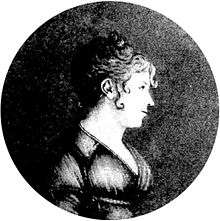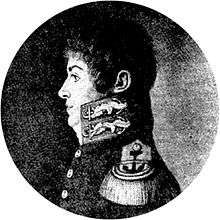Rose de Freycinet

Rose de Freycinet, born Rose Pinon, (1794 – 7 May 1832) was a Frenchwoman who, in the company of her husband, Louis de Freycinet, sailed around the world between 1817 and 1820 on a French scientific expedition on a military ship, initially disguised as a man. While not the first woman to circumnavigate the world, she was the first to record her experiences, in a diary. Being not intended for publication and being both frank and personal musings about people, places and events, her writings represent an important anthropological resource.
Biography
Early years
De Freycinet was born Rose Pinon in Saint-Julien-du-Sault, in the Yonne department, to a middle-class family. Her mother was possibly called Jeanne Pinon; the name of her father is not known today. Jeanne Pinon ran a boarding school for girls. Rose was educated in that school, along with some 40 young ladies from Paris.[1]
Rose was the oldest daughter. Her father died while she was relatively young, followed by her brother, leaving Rose with the responsibility of looking after her sisters. She had a younger sister, Stéphanie, who later also took to the sea and sailed for Mauritius in 1818; Stéphanie married a civil servant, M. Maillard, who later repudiated her.[1]
Marriage to de Freycinet

At age 19, Rose married 35-year-old Louis Claude de Saulces de Freycinet, a member of the French aristocracy. The difference in social class proved no impediment for a happy marriage; by all accounts her in-laws loved and respected her, and throughout her life Rose maintained an animated correspondence with her in-laws, wherever her travels took her.[1]
Aboard the Uranie
Louis de Freycinet had earlier participated in the Baudin voyage that produced the first map of the Australian coastline in the period 1801-3. It is on that voyage he would have been aware of his leader Nicolas Baudin's meeting with Matthew Flinders and of their virtually simultaneous proving that New Holland of the Dutch and New South Wales of Cook were part of one island continent Australia. Displaying considerable cartographic skill, when Baudin's second ship was sent home under Jacques Hamelin laden with specimens and records, de Freycinet was elevated above others to command Casuarina, a small vessel purchased in order to continue the surveys. After finalising an account of the voyage after the death of both Baudin and the voyage anthropologist François Peron who attempted to complete the account, in 1817 he was given command of the Uranie on an expedition under the auspices of the French Navy and the Ministry of the Interior, in which Louis Isidore Duperrey, Jacques Arago, Adrien Taunay the Younger, and others went to Rio de Janeiro to perform various scientific measurements and to collect specimens in natural history. Newly married to Rose Pinon and perhaps aware of Flinder's imprisonment and his enforced separation from his wife Ann, they conspired to avoid a similar fate aboard. Dressed in men's clothes; Rose deFreycinet became the first woman to write an account of her experiences circumnavigating the world.[2][3]
To prepare the ship for his wife's presence, de Freycinet had the living quarters of the corvette renovated (they were refurbished and extended, even at the expense of the ship's navigability), and much attention was paid to hygienic standards aboard the ship, food safety, and health. Apparently, becoming a stowaway was Rose's own idea; she may have hatched the plan as early as 1815, and probably solidified her scheme after her husband received approval for the expedition, in October 1816. She went on board on 16 September 1817; report of her presence reached the French media soon after, leading to sensational reports in the press and "indignation in official circles." The presence of women aboard Navy vessels was illegal, and it is possible that the Navy, the Ministry of the Interior, and the press learned of Rose's presence from an officer who was removed to make way for her. At any rate, Rose initially dressed as a man, and even visited the governor of Gibraltar dressed in "a blue frock-coat with trousers to match."[1]
The Navy was powerless, since the first French port of call for the Uranie was Réunion, in the Indian Ocean, which was not reached until 1818. When the ship did land there, the local governor was unable or unwilling to act, swayed as he was, according to Rose, by her husband's arguments and her charm. A court martial that investigated the shipwreck, in 1820, never mentioned Rose's presence.[1]
The expedition brought back a great number of scientific specimens, including minerals, plants, insects, animals, despite the shipwreck of the Uranie in 1820 in the Falkland Islands. According to Jacques Arago, the artist who had been hired to do botanical and other illustrations and who was the only civilian on board, during the shipwreck Rose de Freycinet behaved herself admirably.[1] Her diary, however, was not published until 1927.[4]
Death
In Paris, 1832, Louis fell ill with cholera. With a Dr. Gaimard, who had also traveled aboard the Uranie, Rose nursed him back to health, even though she suffered from a stomach ailment. However, she herself became ill, and died on 7 May 1832.[1]
Legacy and publications
Rose de Freycinet's name is remembered in the Rose Atoll, in what is now American Samoa, named for her by her husband in 1819 and a dove the Colomb Pinon. Her diary was not published until 1927.
Rose de Freycinet's life and adventures were recounted by Marnie Bassett, Realms and Islands (1962)[5] and by Marc Serge Rivière, A Woman of Courage: The journal of Rose de Freycinet on her voyage around the world, 1817-1820 (2003). Interest in her and her diary led to a renewed interest in the wreck of the Uranie in the Falkland Islands. In 2001 an expedition organized by the Western Australian Museum "conducted research, search and survey aimed at adding to the body of knowledge about the de Freycinets, their ship and their camp." The wreck was relocated and a report into the extensive survivor's camp and the wreck was prepared[2]
Journal (diary)
M. de Freycinet's journal was acquired by the State Library of New South Wales, based in Sydney, in 2015. The journal, as well as paintings by the expedition's artist, Jaques Arago, attest to her presence ashore in Australia at various places including Shark Bay, Western Australia and later in Sydney. [6]
References
- 1 2 3 4 5 6 7 Rivière, Marc Serge (2003). A woman of courage: The journal of Rose de Freycinet on her voyage around the world, 1817-1820. National Library Australia. pp. xi–xxiv. ISBN 978-0-642-10767-1.
- 1 2 McCarthy, Michael (2005). "Rose de Freycinet and the French Exploration Corvette L'Uranie (1820): a Highlight of the 'French Connection' with the 'Great Southland'". International Journal of Nautical Archeology. 34 (1): 62–78. doi:10.1111/j.1095-9270.2005.00044.x.
- ↑ "Rose de Freycinet, 1817-1820". Journeys of Enlightenment: French Exploration of Terres Australes. Western Australian Museum. Retrieved 12 January 2011.
- ↑ Freycinet, Rose de (1927). Charles Duplomb, ed. Journal de Madame Rose de Saulces de Freycinet, d'après le manuscrit original accompagné de notes. Paris: Société d'Editions Géographiques, Maritimes et Coloniales.
- ↑ Sayers, Stuart (28 April 1962). "A French Wife's Voyage Around the World in Defiance of Orders". The Age. Retrieved 12 January 2011.
- ↑ Rose de Freycinet, a stowaway French captain's wife in colonial Sydney, Earshot, ABC News Online, 4 May 2015, accessed 6 May 2015
External links
- "The Uranie Voyage, Rose and Louis deFreycinet, the wrecksite and camp, expedition log". Western Australian Museum. 2003. Retrieved 12 January 2011.